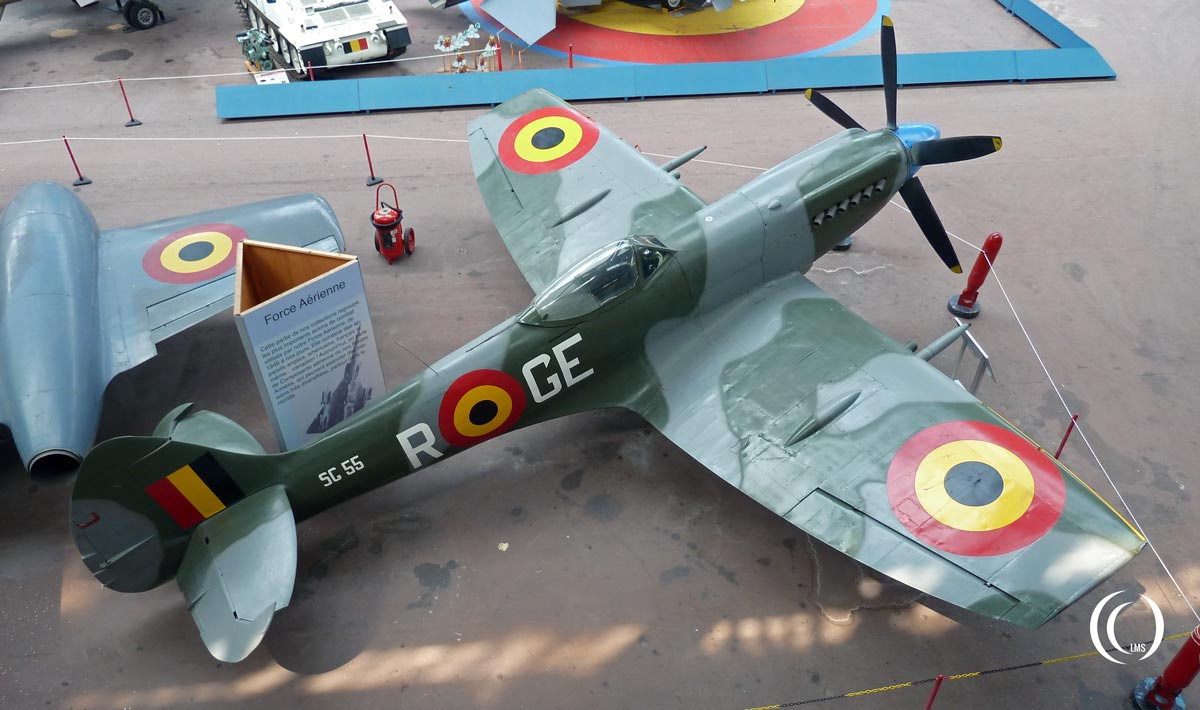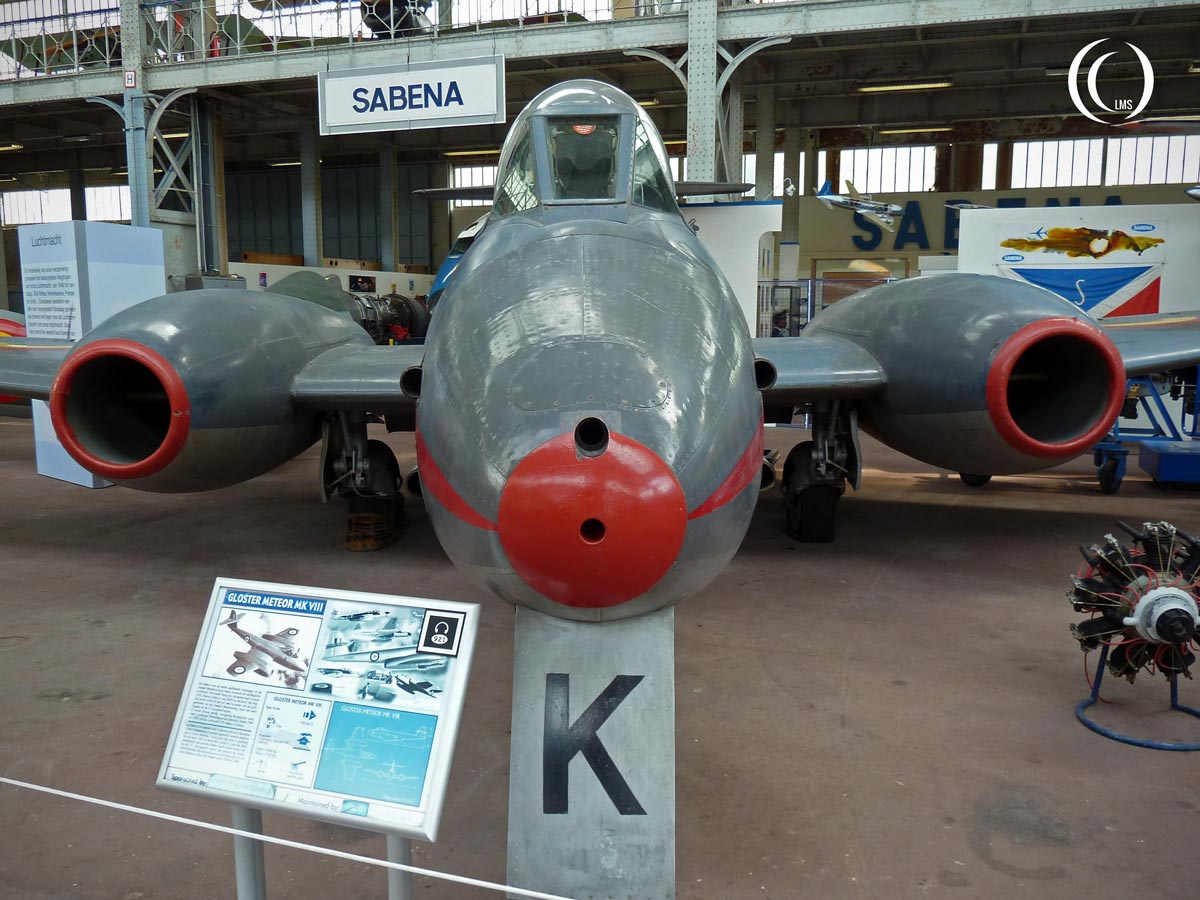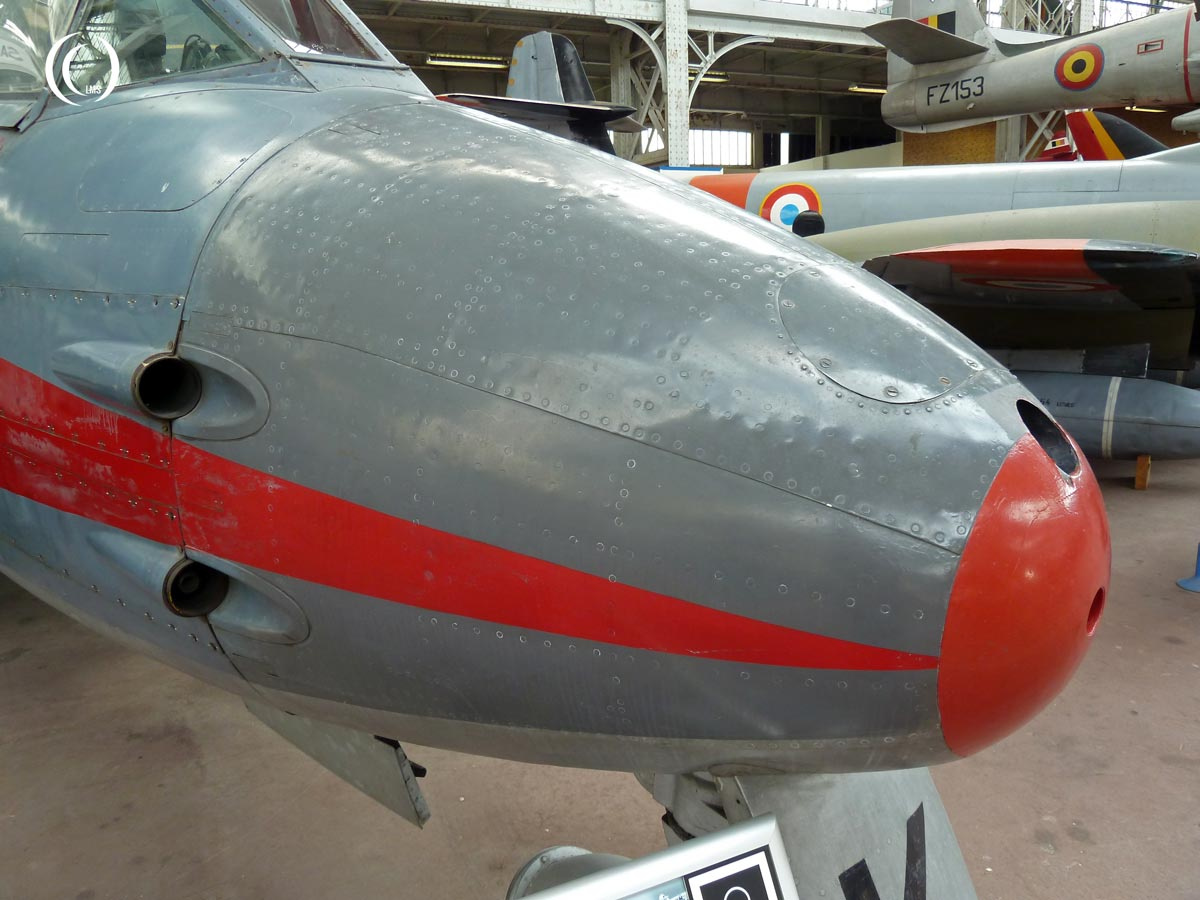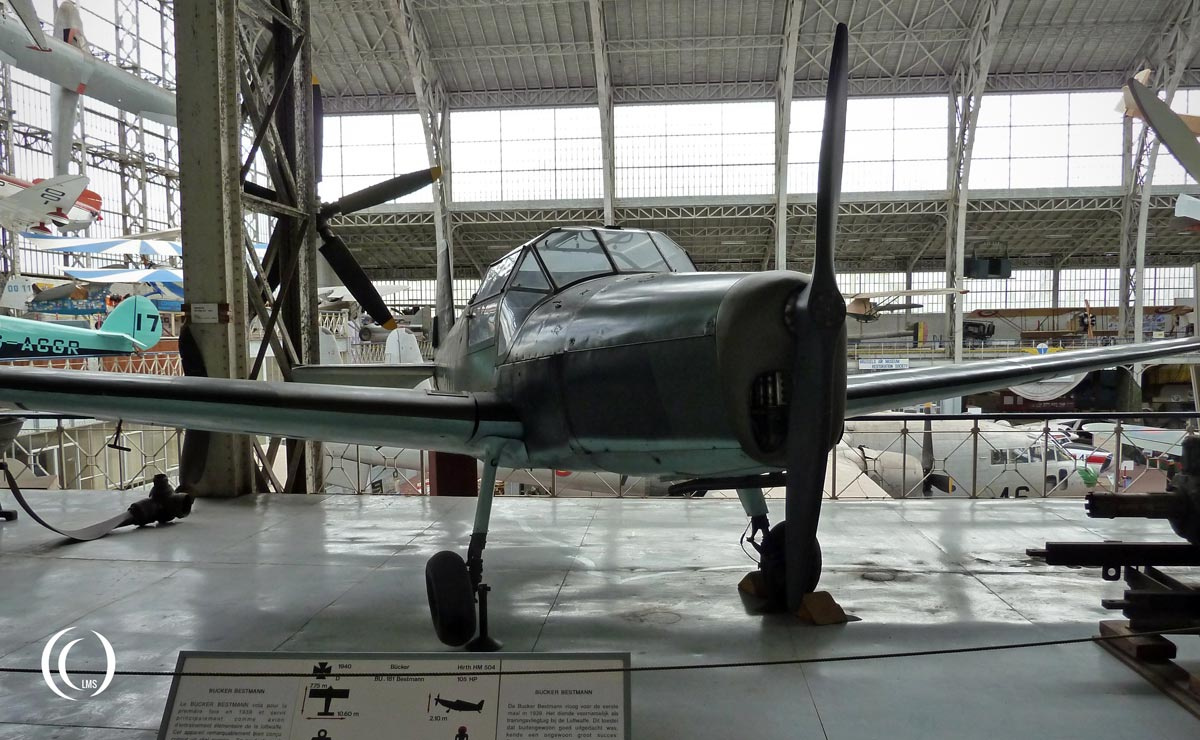The Royal Museum of the Armed Forces and Military History is an enormous museum with an impressive collection that is said to be one of the largest in the world. It contains a diversity of items and art from all military disciplines and branches over a period of 10 centuries.

Because of the enormous collection, this post has become quite a vertical scroll on itself I’m afraid. Before you curse LandmarkScout on this, try to think of it as a small taste of what the actual visit to the museum will be like.
WWII Allied Aircraft
The museum has a large collection of military airplanes. Even though the exhibition hall is huge, the airplanes on display are cramped together, which makes it kind of a challenge to shoot a nice picture, let alone properly admire them. There is always a wing or a tail of another plane in your view. What makes up for that is the pleasant surprises you get, discovering one unique piece after the other stuffed away in the crowded space.
Underneath just a short selection of aircraft relevant to WWII on display at the museum.
North American AT-6D Harvard III
This North American T-6 “Harvard” (RAF) or “Texan” (USAAF) was a very popular trainer aircraft during WWII. The AT-6D is a later version and was used by the Belgian Air Force between 1946 and 1961.

Douglas A-26B Invader
The American Douglas A-26B Invader entered the war in 1943 on the Pacific theater for the USAAF where it was more or less rejected by the Fifth Air Force. Only after it entered the European theater when it was issued to the Ninth Air Force from September 1944 the Invader earned its recognition.
This Douglas A-26B Invader has an “eight gun nose” and was used for strafing and bombing targets.

The Douglas A-26B Invader had two General Electric W35 gun turrets, one on the top and one on the bottom, which could be remotely controlled by the Gunner from a central position. Each turret was fitted with two M2 Browning machine guns. The top turret could be fixed in a forward position and controlled by the pilot. The bottom turret wasn’t for defense purposes but for use in ground attacks.

De Havilland Mosquito Mk 30
Although the RAF at first did not show any interest in the De Havilland Mosquito, once the war broke out the aircraft proved it was capable of performing many tasks. Mosquitoes were used in different roles like medium bombers, reconnaissance, anti-submarine, tactical strike fighter and night fighter.
Mark 30 Mosquitoes were night fighters and this type was especially built for high altitudes. The plane was powered by two Rolls Royce “Merlin 76” engines and has a so-called “Bull” nose. It is the final variant of the Mosquito in WWII.


Bristol 149 Bolingbroke Mk. 4 T
The Bristol 149 Bolingbroke is a maritime reconnaissance version of the Bristol Blenheim Mk. 4 light bomber and was used by the Royal Canadian Air Force mainly for patrol duties on the Pacific and Atlantic coasts of Canada. A characteristic feature of the Bolingbroke is the partly scooped out upper left part of the nose, to give the pilot a better field of view.
The “T” designation means that the aircraft was a trainer version.




Hawker Hurricane II C
The British Hawker Hurricane was used as a fighter and dive-bomber during WWII. Although its role (and its numbers) proved decisive in the Battle for Britain, the Hurricane was outperformed by its adversary the German Messerschmitt Bf 109E in the European Theater of War.

Fairey Battle I. TT
The Fairey Battle was a one engined (Rolls Royce Merlin I) light bomber and operated by a crew of three. The displayed version belonged to the Royal Canadian Air Force.

Vickers Supermarine Spitfire LF Mk. IX
Tucked away under the wing of the displayed Fairchild C-119G Flying Boxcar is a Vickers Supermarine Spitfire LF Mk. IX. This iconic airplane of WWII definitely deserves a better spot. The Mk. IX was put into service from July 1942 as an interceptor for low and mid-range altitudes. This displayed Spitfire version had shortened wings so it could turn faster at a higher velocity. The plane is ex-RAF and is decorated with black and white “invasion”stripes as used during D-Day.
The museum also has another Vickers Supermarine Spitfire on display of a later version.


Vickers Supermarine Spitfire Mk. XIV
This is the other one of two Vickers Supermarine Spitfires the museum has on display. This version was built near the end of WWII and fitted with the powerful Rolls Royce “Griffon” 65 engine, a five blade propeller and an aerodynamic canopy.



Gloster G.41 Meteor F.8 (Mk VIII)

The Gloster Meteor is the first operational Allied jet-fighter of WWII. The plane made its maiden flight in March 1943 and performed in active duty for the RAF from July 1944. It’s late development kept it from taking part in the air battles over Europe, but it was used to defend British airspace. More than 3900 Gloster Meteors were built and the plane was used in active service by many countries well beyond WWII.
This Meteor F.8 is also a post WWII version and was greatly improved compared to its previous versions. A significant change was the longer fuselage and modified tail piece to gain more stability.
On a side note: The museum also has a Gloster Meteor Night Fighter (NF) from 1950 on display.




WWII Axis Aircraft
The large hall has a large balustrade that serves as a second floor. Next to some very interesting WWI aircraft in a well preserved state and other items that have to do with aviation, the museum also has a German section in the far left corner, except for “Iron Annie” hanging in the middle of the large hall.
Junkers Ju 52 3m97e
Another icon, the Junkers Ju 52 3m97e a.k.a “Auntie Ju” or “Iron Annie”. The tri-motor plane was a transporter for both civilian and military purposes. During WW2 the plane was mainly used by the Luftwaffe as a troop transport and cargo plane, though in some cases it was taken into action as a bomber or for paratrooper operations.
Adolf Hitler made extensive use of a Junkers Ju 52 as his personal plane during his political campaigns in Germany, until it was replaced by a Focke-Wulf Fw 200 “Condor” after 1939. The Junkers Ju 52 is in a beautiful condition.


Bücker Bü 181B Bestmann
The Bücker Bü 181B “Bestmann” was a favoured training airplane during WW2 for the German Luftwaffe and a considerate number of them were built.


Fieseler Fi 156C-3 Storch
The Fieseler Fi 156C-3 Storch was used by the Luftwaffe as a liaison, reconnaissance, transport and communications airplane in WWII. The Storch’s characteristics were ideal for these purposes, as it only needed an exceptionally short airstrip to take-off or land. This was a big benefit at the ever moving front, moreover because the airstrip could just be some dirt or grass.
The flying characteristics are equally impressive, for the Storch only needed a minimal speed of 50km/h to be airborne.
The plane had such a good reputation that captured Storch’s were popular among Allied officers at the front. For example Field Marshal Montgomery made use of a Fieseler Storch as a personal aircraft.
Between 1944 and March 1945 the C-3 version was built by Nazi Germany as well as by the liberated French who designated them MS 500 (after the factory Morane-Saulnier) and fitted them with the remaining stock of original Argus engines. A total of 1755 C-3’s were produced by both sides.
I have seen pictures of this Storch with wings, but when we visited the wings were taken off and stored on the balustrade balcony. I hope they have put them back on again now.


Miscellaneous
Even if you get a little worn out by looking at so many airplanes after a few hours, try not to lose focus on the other objects and items displayed around them, for there are some real treasures hidden among them. Some do not even have an information sign (at least not where we expected it) so it’s sometimes better to just shoot it with your camera and do your homework later.
WB (Waffen-Behälter) 151/20 dual cannon pod

This is a WB (Waffen-Behälter) 151/20 under-wing pod with dual 20mm cannons for Focke-Wulf Fw 190 A-5/U12, A-6, A-7 and A-8 types. The gun pod was part of a so-called R1 “Rüstsatz”. Rüstsätze were field modification kits for various airplanes produced for the Luftwaffe.
For the Focke-Wulf Fw 190 there was a whole range of Rüstsätze available. Depending on the Fw 190’s function, they could be outfitted with a certain /R kit. In search for more firepower against the growing waves of enemy bombers over the Third Reich, the R1 kit was fitted to these type of aircraft for maximum damage.

Brandbomben-Schüttbehälter BSB 1000 for B1-E incendiary bomb
Although this seems another Waffen-Behälter (much like the WB 81A or B for the Ju87 and 88), it is actually a BSB 1000 (BSB: Brandbomben-Schüttbehälter) bomb container for dropping B-1E incendiary bombs. The number indicates how many B-1E’s the containers could hold: BSB-360, BSB-700 and BSB-1000.

Wellington Bomber front gun turret
We couldn’t find any information sign, but we think this is the front gun turret of a Wellington bomber. We are ruling out that it could be the top gun turret of an AVRO Lancaster, because of the wiring coming out the top and the closed back of the turret.

WWII tanks
The museum is claiming to have an important (and large: 250) armored vehicle/tank collection on display including a Hetzer, a KanonenJagdpanzer and a T34, etc. But all we found was a rather disappointing number of tanks in a courtyard. The tanks that were on display during our visit that were relevant to WW2, are almost neglectable.
We later learned that the bulk of this collection is stored at another location named “Fortress Kapellen”, which functions as the exterior depot of the Royal Army Museum in Brussels. We think it would be fair if the museum would warn visitors about this beforehand, especially because the tanks at the “Fortress Kapellen” location are not open to the public, except on “special” days.
M24 “Chaffee”
The M24 Chaffee could be classified as “too little, too late” for the Second World War. The light tank went into production in September 1944 and was widely issued from December 1944. But distribution was slow and many units were still in their old M3 or M5 Stuart tanks by the time the war came to an end.
Even though the M24 had a much bigger caliber of 75mm compared to the Stuart and performed a lot better off-road, because it was a light tank it still wasn’t adequate enough to engage any German tank.


Visit the Royal Museum of the Armed Forces and Military History in Brussels, Belgium
As stated at the top, this museum and its collection is enormous and we definitely recommend it. If you strive to see the whole collection, we would almost recommend extending a visit over two days. Because you know you lost your concentration when you walk past a WWI Whippet tank in 5 seconds thinking; “Oh nice, now where’s the coffee bar”. Be warned.
The admission used to be free, but nowadays you have to pay at the door. Check the museum website for opening hours and admission fees.